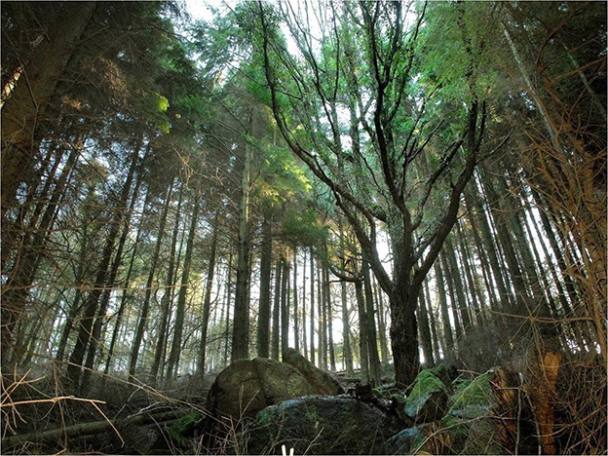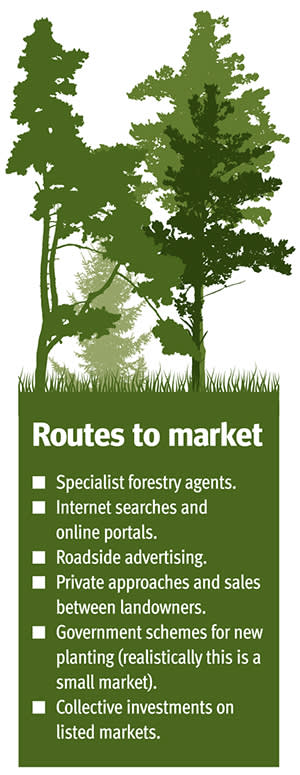It’s the time of year when an eruption of electric-blue is scattered throughout the countryside. One of the best ways to experience trees is to amble through woods on a May dawn, hearing the clamorous wealth of the dawn chorus and experiencing a vivid carpet of bluebells intensely bright in the early light.
Trees might not immediately spring to mind as something to invest in. But people invest in trees from small woodlands to large-scale forestry, for a number of reasons; for the commercial production of timber, for amenity and sporting purposes or, increasingly, for altruistic and environmental reasons.
A better connected world with more information brings more choice to investors. Increasingly, we are seeing more information on, and a greater appetite for, different asset classes – and woodlands is clearly one of those.
This article is for the investor who is considering purchasing woodlands. Special tax treatment is given for commercial woodlands – the main advantage being it is free of inheritance tax (IHT) – something that is often the main attraction for a new investor.
Commercial woodlands
Exemption from income tax, corporation tax, capital gains tax (CGT) and IHT is available on the profits and value of commercial woodlands.
To obtain these tax advantages, woodland or forestry must be in the UK and must be occupied commercially. For the inheritance tax exemption, the woodland need not be in the UK and can be in the EEA. Forestry could therefore be purchased in Scandinavian, Baltic and Eastern European states and get inheritance tax relief, although at the expense of exchange rate risk and other commercial uncertainties. This may not suit every investor. Knowledge of local tax and succession laws would also be essential.
Tax law does not really provide much guidance on what the term ‘commercial woodlands’ means. The income tax definition says that woodlands must be occupied “on a commercial basis” with “a view to the realisation of profits”. Some guidance from a limited number of legal cases is helpful. A person occupying woodlands commercially does so for the long-term sustainable production of raw timber. Trees take a long time to mature, and while nature plays a significant part in that process, an investor can only be occupying commercially if there is a formal business plan designed around planting, managing, thinning and eventually harvesting and selling the timber at a commercial profit. A prudent investor will produce a business plan. That plan will cover many years and often it will show several decades before ‘payback’ can be projected in the case of land bought for new planting, less so for semi-mature woodland.
In my experience, it is essential for an investor to get good upfront advice from a surveyor or land agent experienced in woodlands (see Routes to market, page 39). Buying a piece of woodland may sound simple, but it isn’t. An experienced agent will work with an investor, developing a business plan, looking at the location and risks, taking into account the opportunity for grants, and most importantly the investor’s longer-term aims before sourcing a suitable investment in woodlands or forestry.
To put this into context, an investment in woodland is unlikely to be commercial unless it is of a significant size and easily accessible. An investor would probably pay at least £1m in order to gain any meaningful relief from inheritance tax, but in practice smaller sizes are bought. Although small parcels of woodland change hands for high prices, these often tend to be in the south-east close to urban areas and with development potential on part of the underlying land. Investors in those parcels are not occupying the woodland to profit from the sale of raw timber. In fact, they are merely investing in the site on the expectation of a price rise. Those types of woodland investment will rarely qualify for any tax relief and serial disposals of small plots can often result in the investor being charged income tax at 45 per cent on any gains they make as a land dealer.
The tax position on commercial woodlands can be complex, but the following broad points may help an investor make decisions.
Income tax
Until 30 years ago, revenue profits from commercial forestry were taxable. This meant that costs could also be claimed against an investor’s other sources of income. The upfront costs of planting new land were considerable. Investors inevitably made losses for the first few years and with no revenue on the horizon an investor would never be exposed to income tax.
This provided an opportunity for big earners in the early 1980s to obtain income tax rebates of up to 60 per cent on part of the initial investment. Eventually the woodland could be sold or passed down to heirs with very little tax. Many high-profile investors in the sports and entertainment industry were associated with woodland investment wholly for the tax benefits. As a result, commercial woodland and forestry are now outside the scope of income tax, which means tax rebates for early losses are no longer available.
However, this exemption only really applies to the activity of growing trees, whether standing or felled, for raw timber. Where other activities are carried out, the profits may well be taxable. Examples of woodland operations that are taxable include:
• Growing Christmas trees for wholesale or retail.
• ‘Short rotation coppice’ where stems may be harvested at two to five yearly intervals for woodchip production.
• Primary production of planed timber and timber products.
• Renting woodland for camping, shooting, filming or other recreational activity.
The first three of these activities extend beyond the long-term production of sustainable timber to exploiting trees in other ways. In those cases, a proportion of the costs of planting, managing and harvesting the trees may well be tax deductible. Where the activity is modest and the majority of the woodland is otherwise managed for the long-term growing of timber, the beneficial IHT exemption (see below) should still apply.
Capital gains tax
If an investor is merely selling trees, then whether they are sold standing or felled, the proceeds will not normally be liable to CGT. The sale will usually be part of the planned commercial operation – either the thinning of trunks from a semi-mature woodland or mature harvesting. In those cases, the receipts would be exempt under the income tax rules, but this further exemption puts it beyond doubt that CGT will not apply, either.
Where woodland is sold in its entirety – that is to say both the land and the trees are sold – only the amount paid for the trees will be exempt from tax. That part of the price paid for the underlying land will be chargeable to CGT, currently at a marginal rate of 20 per cent, on any increase in value since the original investment. This is where an investor’s property agent will be able to help with apportioning the values between the taxable land and the non-taxable trees, hopefully in the investor’s favour.
Let’s say an investor, Simon, bought woodland for £500,000. Of the acquisition price, £400,000 of value relates to the trees, with £100,000 for the land. Simon is now disposing of the woodland for £800,000 and at the time of sale the value of the trees has been valued by his forestry agent at £650,000.
Ignoring any allowances or costs associated with acquisition the gain is chargeable as follows:
| £ | £ | |||
| Disposal proceeds | 800,000 | |||
| Less | Amount related to growing trees | 650,000 | 150,000 | |
| Cost of land | 100,000 | |||
| Chargeable Gain | 50,000 |
This gain is eligible for the annual exemption, currently worth £11,700, if Simon has not otherwise used it. Any CGT payable can be spread over 10 years if the disposal is not a sale, but a gift, for example to his younger generations. Interest is payable on any unpaid instalments, but is non-compound.
However, if the woodland includes parts that have been turned over to recreational use, for example camping, adventure parks or trail riding, HM Revenue & Customs (HMRC) would expect an investor to apportion a further amount of the consideration to the amenity use of the land, so that the taxable proportion includes not only the underlying land but a proportion of the overall value.
An investor using funds from a qualifying earlier business sale may be able to claim ‘rollover relief’ so that any CGT that would otherwise have arisen on the earlier sale is instead rolled into the woodland purchase. This will subsidise the purchase cost. Here it is essential to have a strong business plan on the woodlands, otherwise HMRC may argue the claim is a ‘sham’ and would most certainly apply penalties.
Inheritance tax
Commercial woodland will qualify for IHT relief under the business property relief code where it meets qualifying conditions. The first is that, once again, the woodland must be occupied commercially with a view to a profit. This is where a well-prepared business plan, periodically updated, comes in useful. Provided there is strong evidence at the outset the woodlands bought or planted have strong commercial potential, and there is year on year inspection and management, tax relief should be available in as little as two years. In the previous above, Simon could expect to hand to his heirs woodland worth in excess of £800,000 free of IHT.
Where Forestry Commission (or Scottish Forestry Commission) grants are available for planting or fencing, the ability for an investor to achieve the inheritance tax exemption may be enhanced. This is because major grants will often be given only where a woodland or forestry scheme can be shown to be both profitable and sustainable – and it follows this is after submitting an acceptable Forestry Management Plan.
If there is some doubt whether the investor – or rather their executors – can show the woodland operation is commercial, running another profitable activity on the same site is an equally acceptable way of achieving the relief. These could include commercial shooting, ‘glamping’, festivals or the sale of wood products. An investor thinking of diversifying in this way needs to ensure they have the right insurances and local authority planning consents in place, however.
Value added tax
Land is generally exempt from VAT, unless an investor has elected to put the land into the VAT rules by waiving the exemption. This is a process also known as ‘opting to tax’ the land. It is important for an investor to know whether the vendor has opted to tax the land or not. If they have, the land will be sold with VAT – which at 20 per cent will be a considerable extra cost.
In those cases an investor may wish to register for VAT and also make an election on the land they wish to acquire before they purchase it. That way they will be able to recover the VAT from HMRC. In many cases, the purchase may well qualify for a special exemption if it is both sold and bought as a ‘going concern’, which means the vendor does not need to charge VAT. The purchaser still has to register for VAT, however.
It is normally going to be the case that VAT registration is beneficial, particularly where the occupation is commercial because then VAT can be recovered on a range of costs. However, it is an area where specialist VAT advice must be obtained.
Other woodlands
Woodland that is not occupied commercially has different tax treatment, although in practice the activity and profits may not be material. Most non-commercial woodlands will be small and may consist of the following:
• Ancient, protected woodland.
• Woodland that is small in size, or remote or difficult to access. The ability to manage and harvest timber both profitably and sustainably is difficult or impossible. Land in this category is often bought for environmental purposes or for the owner to enjoy.
• Screening or shelter belts acquired with houses and other buildings such as farms.
In these cases, there will not usually be receipts from the sale of trees, but where there are they are taxable. They may be modest, such as the sale of firewood. Often the costs of land maintenance will reduce the profit to nil.
For CGT purposes, the value of the land that includes the trees standing on it is liable to tax when sold based on any increase in value. In some cases, relief from CGT may be due where trees are planted on land that goes with the main home provided it qualifies under the ‘main residence’ relief rules. If smaller parcels of woodland are bought or added to agricultural land, they may qualify for other forms of CGT reliefs.
Where, as is sometimes the case, an investor buys small parcels of land specifically to sell, taking advantage of general uplifts in value over the short term, they may be liable to income tax on those profits at 45 per cent as a deemed trader in land. This will be the case if they receive no income from it or have no personal enjoyment from it – the two key hallmarks of any investment. I recall a challenge from HMRC some years ago on an individual who acquired small parcels of woodland with fishing rights. When he retired and sold them we were able to prove to HMRC with photographs that he did indeed fish from each location during the season, therefore the gains on sale were charged to CGT and not income tax when it was then 50 per cent.
While there is no business property relief for woodland that is not occupied commercially, it may qualify for a special inheritance tax relief, often called Woodland Relief, on the death of the owner. The relief defers the IHT on the value of the trees until they are sold, which is usually by the deceased’s heirs at a later date, often years away. In turn, the heirs may pass the land and trees on to their children so that the tax on the trees is deferred until they are mature and sold. The IHT on the underlying land value is payable, but will often be low and may be spread over 10 years if the heirs elect. This is a useful relief because the woodland may not have to be sold to pay the tax. Death-bed tax planning is not allowed, however, because the relief will only be due if the woodland was owned for five years before death, or inherited.
Summary
Commercially managed woodlands can provide a shelter from IHT and need not only be in the UK but any state in the EEA.
Getting professional advice from a land agent with woodlands experience is essential, not only to make a good initial investment, but to assist with any business plans that will support the case for IHT relief.
A woodland investment may not provide an income for the investor, or even for their children. But it may provide their children with a pension and it may provide their grandchildren with an education, with the underlying investment protected from IHT.
More than anything, woodland is to be enjoyed. Just because it is under commercial occupation does not prevent the owner from also enjoying it and from experiencing those dawn walks and the bluebells.
Frank Nash is partner at Blick Rothenberg











